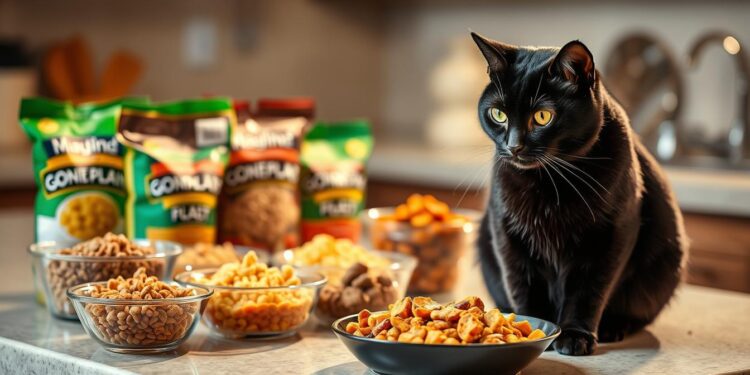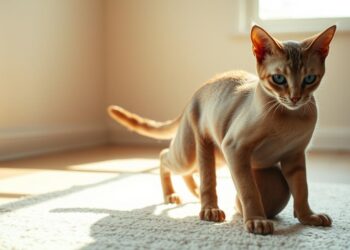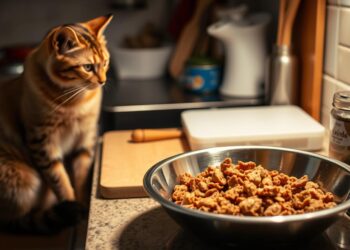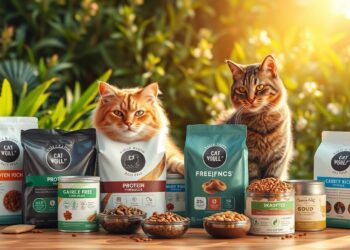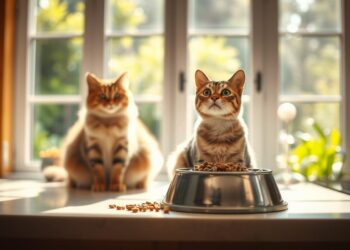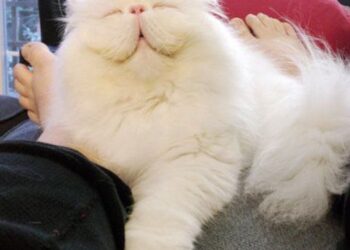As a cat owner, I’ve experienced the frustration of dealing with a finicky feline. My cat, once a voracious eater, began turning up its nose at meal times. It was a worrying sign, and I knew I had to take action to ensure its overall health and well-being.
Picky eating is a common issue in cats, often caused by medical conditions, food preferences, or environmental factors. Addressing this issue is crucial to prevent malnutrition and other health problems. In this article, I’ll share my experience and provide tips on how to help a picky cat eat by exploring various picky cat eating solutions and discussing the best cat food for picky eaters.
Understanding Picky Eating in Cats
The phenomenon of picky eating in cats is multifaceted, involving both physiological and environmental aspects. To address this issue effectively, it’s essential to understand the underlying reasons and identify the signs of picky eating in your cat.
Reasons Behind Picky Eating
Picky eating in cats can be attributed to various factors, including medical conditions and personal preferences. Medical conditions such as dental disease, kidney disease, and gastrointestinal issues can make eating uncomfortable or painful, leading to a decrease in appetite or selectivity in food choices. Additionally, cats may develop picky eating habits due to their individual preferences for certain textures, flavors, or temperatures of food.
Some cats may also be influenced by environmental factors, such as the cleanliness of their food and water bowls, the location of their feeding area, or even the presence of other pets during meals. Understanding these factors is crucial in determining the best approach to encourage healthy eating habits in your cat.
Signs Your Cat Is a Picky Eater
Identifying whether your cat is a picky eater involves observing their eating habits and behavior. Common signs include:
- A lack of interest in their regular food
- Preference for specific textures or flavors
- Eating very slowly or hesitating to start eating
- Turning away from food or leaving it uneaten
By recognizing these signs and understanding the potential reasons behind your cat’s picky eating, you can begin to develop strategies to encourage a more varied and healthy diet.
Key Takeaways:
- Picky eating in cats can be caused by medical conditions or personal preferences.
- Environmental factors can also influence eating habits.
- Observing your cat’s behavior and eating habits is crucial in identifying picky eating.
Choosing the Right Cat Food
Picky eaters require a thoughtful approach to cat food selection, focusing on both type and quality. The diverse range of cat foods available can make choosing the right one challenging, but understanding your cat’s individual preferences and dietary needs is key.
Types of Cat Food: Dry vs. Wet
Cat food comes in two primary forms: dry and wet. Dry cat food is convenient and helps maintain dental health by reducing tartar buildup. On the other hand, wet cat food has a higher moisture content, which can be more appealing to cats and help with hydration.
When deciding between dry and wet food, consider your cat’s preferences and health needs. Some cats prefer the taste and texture of wet food, while others enjoy the crunch of dry kibble. A combination of both can also be a viable option, offering variety and catering to different aspects of your cat’s health.
The Importance of Quality Ingredients
The quality of ingredients in cat food significantly impacts your cat’s health and eating habits. High-quality cat foods contain named protein sources (e.g., chicken, salmon), whole grains, and a balanced mix of vitamins and minerals.
When selecting a cat food, look for products with:
- Named protein sources as the first ingredient
- Whole grains or vegetables for fiber and nutrients
- Avoiding fillers and by-products
- A balanced fatty acid profile for skin and coat health
| Cat Food Type | Key Ingredients | Benefits |
|---|---|---|
| Dry Cat Food | Whole grains, named protein sources | Convenient, supports dental health |
| Wet Cat Food | High moisture content, named protein sources | Appealing to cats, aids hydration |
| Combination | Varies | Offers variety, caters to different health needs |
By focusing on high-quality ingredients and considering your cat’s preferences for dry or wet food, you can make an informed decision that encourages healthy eating habits.
Gradual Transition to New Foods
A gradual transition to new foods is crucial for picky cats to prevent digestive upset and encourage eating. Cats are creatures of habit, and their eating habits can be quite sensitive to change.
When introducing new foods, it’s essential to do so in a way that minimizes stress and maximizes the likelihood of acceptance. This involves not just the type of food but also the manner in which it is introduced.
How to Introduce New Flavors
Introducing new flavors to your cat’s diet should be done gradually. Start by mixing a small amount of the new food with their current food. The proportion of new to old food should be gradually increased over time.
- Begin with a ratio of 25% new food to 75% old food.
- Gradually increase the proportion to 50% new food over 7-10 days.
- Continue to 75% new food for another week.
- Finally, transition to 100% new food.
This gradual introduction helps your cat’s digestive system adjust to the new food, reducing the risk of gastrointestinal upset.
Timing the Food Changes
The timing of food changes is as important as the method. It’s recommended to make these changes during periods of stability, avoiding times of stress such as during moves or changes in the household.
Key considerations for timing include:
- Monitoring your cat’s health and appetite during the transition.
- Avoiding changes during extreme weather conditions.
- Being patient and not rushing the transition process.
By carefully managing the introduction of new foods and considering the timing, you can help your picky cat adjust to new eating habits, enhancing their overall dining experience and nutritional intake.
Enhancing the Food Experience
To make mealtime more engaging, consider enhancing your cat’s food experience. Picky eaters often require a bit more creativity to encourage them to eat. Simple adjustments can make a significant difference in their dining experience.
Adding Toppers to Tempt Their Taste Buds
One effective way to entice a picky cat is by adding toppers to their meal. Toppers can include a variety of ingredients such as canned tuna, chicken, or even a sprinkle of catnip. These additions can make the meal more appealing and stimulate their appetite.
- Canned fish or meat
- Catnip or other herbs
- Plain yogurt or cottage cheese
Experimenting with different toppers can help you identify what your cat prefers. It’s essential to introduce new toppers gradually to prevent digestive upset.
Experimenting with Temperature
The temperature of the food can also impact a cat’s willingness to eat. Warming the food to room temperature or slightly above can release the aromas, making it more appealing. Some cats prefer their food slightly warmed, while others like it straight from the refrigerator.
- Try warming the food slightly in the microwave (ensure it’s not too hot).
- Serve the food at room temperature.
- Experiment with chilled food to see if your cat prefers it that way.
By adjusting the temperature and adding toppers, you can make mealtime more enjoyable for your cat. These tips for feeding a picky cat can help in making their dining experience more engaging and satisfying.
Establishing Regular Feeding Routines
Regular feeding times can help reduce stress and make mealtime more enjoyable for cats. By establishing a consistent feeding routine, cat owners can encourage their pets to be more adventurous eaters.
Consistency and Curiosity
A consistent feeding schedule helps in reducing a cat’s stress levels, making them more receptive to new foods. When cats know what to expect, they’re more likely to explore different flavors and textures.
Benefits of Consistency include:
- Reduced stress during mealtime
- Increased curiosity about new foods
- A more predictable eating routine
Feeding Schedule Tips
Creating an effective feeding schedule involves understanding your cat’s preferences and needs. Here are some tips to consider:
| Tip | Description | Benefit |
|---|---|---|
| Feed at the same times daily | Establish a routine that your cat can rely on. | Reduces stress and anxiety |
| Measure food portions accurately | Avoid overfeeding by measuring the exact amount needed. | Maintains a healthy weight |
| Avoid free-feeding | Limit access to food to specific meal times. | Encourages eating what’s provided |
By implementing these strategies, cat owners can help their picky eaters become more willing to try new foods, ultimately leading to a more balanced diet.
Creating a Stress-Free Eating Environment
Ensuring your cat eats in a stress-free environment can be a game-changer for their eating habits. A calm and comfortable dining space encourages cats to eat more willingly, especially for those with finicky appetites.
The Ideal Cat Feeding Area
Creating an ideal feeding area involves more than just placing the food bowl on the floor. It requires a quiet, comfortable, and distraction-free zone where your cat can eat without feeling anxious or stressed. Choose a location that is away from high-traffic areas and noisy appliances.
Consider the following tips to create a serene feeding area:
- Place the food bowl in a quiet corner of a room.
- Avoid areas near litter boxes or other sources of strong smells.
- Ensure the feeding area is clean and free from clutter.
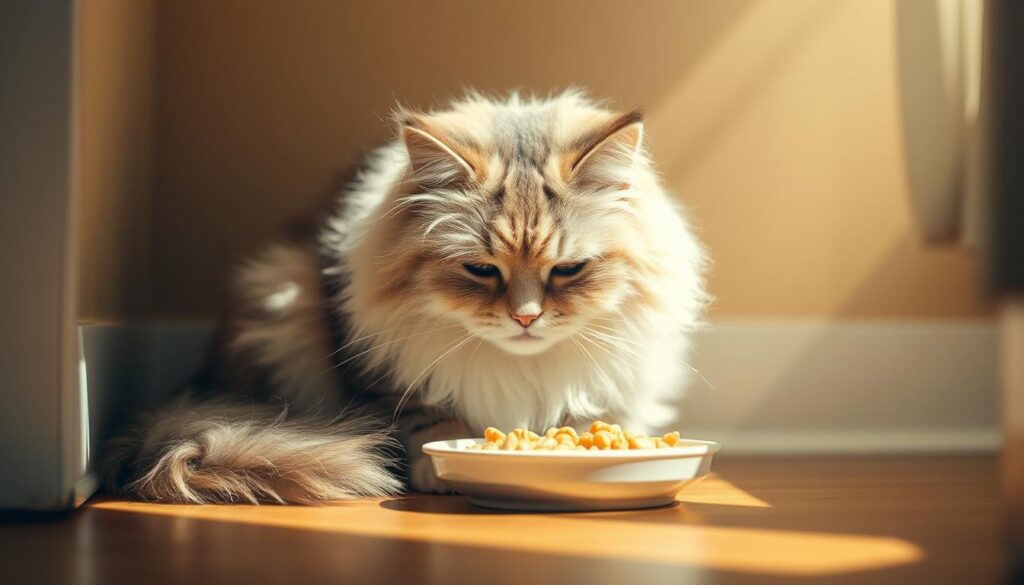
Reducing Competition with Other Pets
If you have multiple pets, it’s essential to reduce competition during mealtime. Separate feeding areas can help minimize stress and allow each pet to eat without feeling rushed or threatened.
| Tips for Reducing Competition | Benefits |
|---|---|
| Feed pets in separate rooms. | Reduces stress and competition. |
| Use barriers or baby gates to separate feeding areas. | Creates a sense of security for each pet. |
| Stagger feeding times. | Prevents food guarding and competition. |
By implementing these strategies, you can create a stress-free eating environment that encourages your cat to eat more comfortably and willingly, even when introducing new foods or dealing with picky eating habits.
Using Positive Reinforcement
Positive reinforcement is a powerful tool in transforming your cat’s eating habits. By associating mealtime with positive experiences, you can encourage your cat to be more adventurous with their food choices.
Rewarding Your Cat for Trying New Foods
One effective way to use positive reinforcement is by rewarding your cat for trying new foods. This can be done by offering small treats immediately after they taste the new food. The key is to create a positive association with the new food.
For example, you can follow this simple process:
- Introduce a new food alongside their regular meal.
- Encourage them to try the new food.
- Reward them with a treat if they take a bite.
Consistency is crucial. Repeat this process regularly to reinforce the behavior.
Creating a Positive Mealtime Atmosphere
Creating a positive mealtime atmosphere is also vital. This involves making the dining area comfortable and stress-free. Ensure the feeding area is quiet and away from high-traffic zones in your home.
Some additional tips to enhance mealtime include:
| Tip | Description | Benefit |
|---|---|---|
| Use a clean feeding area | Ensure the feeding area is cleaned regularly | Reduces stress and makes mealtime more enjoyable |
| Minimize distractions | Turn off the TV and reduce noise levels | Helps your cat focus on their meal |
| Maintain a consistent feeding schedule | Feed your cat at the same times each day | Regulates their appetite and expectations |
By implementing these strategies, you can make mealtime a more positive experience for your cat, encouraging them to be less picky and more willing to try new foods.
Identifying Allergies or Sensitivities
Allergies and sensitivities to food ingredients can significantly impact your cat’s quality of life. It’s crucial to identify these issues to provide the best possible care for your pet.
Signs of Food Allergies in Cats
Food allergies in cats can manifest in various ways. Common signs include:
- Itching and scratching
- Skin lesions or hot spots
- Digestive issues such as diarrhea or vomiting
- Ear infections
If your cat exhibits any of these symptoms, it’s essential to consult with your veterinarian to determine the cause.
Consulting Your Veterinarian
Your veterinarian plays a vital role in diagnosing and managing food allergies or sensitivities in your cat. They can help you:
- Identify the allergen or irritant
- Recommend appropriate dietary changes
- Monitor your cat’s progress and adjust the plan as needed
Consulting with a veterinarian is a critical step in ensuring your cat receives the right care.
| Symptom | Possible Cause | Action |
|---|---|---|
| Itching and scratching | Food allergy or skin condition | Consult veterinarian, consider dietary change |
| Digestive issues | Food sensitivity or allergy | Discuss dietary adjustments with veterinarian |
| Ear infections | Allergy or infection | Veterinary consultation for proper diagnosis |
By working closely with your veterinarian and being aware of the signs of food allergies or sensitivities, you can help your cat enjoy a healthier, more comfortable life.
The Role of Hydration in Diet
Adequate hydration is essential for your cat’s health, affecting their appetite and overall diet. Ensuring your cat has access to fresh water at all times is crucial, as dehydration can lead to a decrease in appetite and potentially exacerbate picky eating habits.
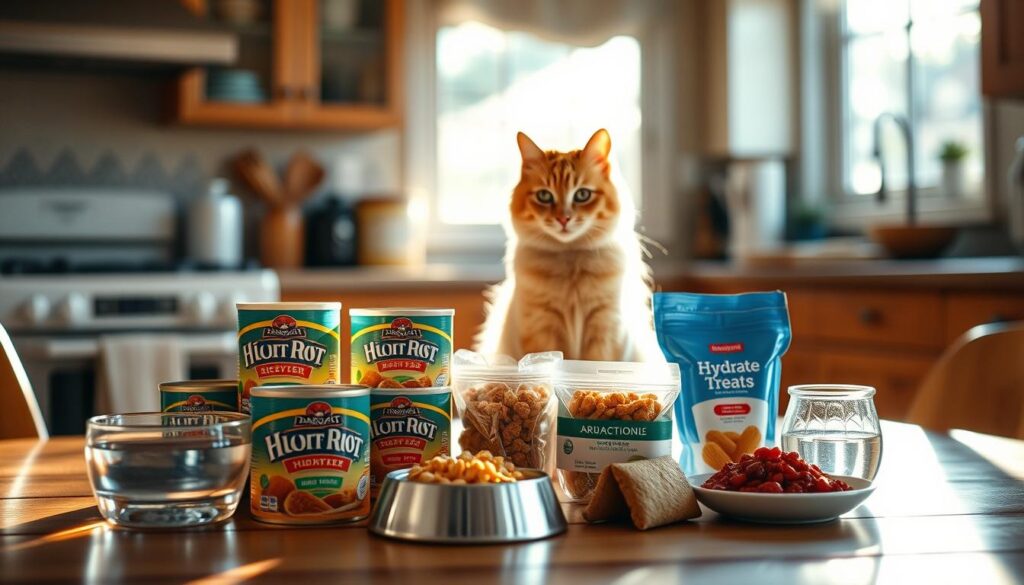
Affecting Appetite
Hydration significantly impacts your cat’s appetite. Dehydration can cause a decrease in appetite, making your cat even more finicky. Ensuring your cat is well-hydrated can encourage a healthier appetite and make mealtime more engaging.
Tips for Encouraging Hydration:
- Ensure access to fresh, clean water at all times.
- Consider using a water fountain to encourage drinking.
- Place water bowls in multiple locations around the house.
Incorporating Broths and Soups
In addition to water, incorporating broths or soups into your cat’s diet can be an effective way to increase hydration. These can be particularly appealing to picky eaters and add variety to their diet.
Benefits of Broths and Soups:
- Adds moisture to the diet, aiding hydration.
- Can be used as a topper to enhance flavor and encourage eating.
- Provides essential nutrients and can be a source of protein.
When introducing broths or soups, start with small amounts to prevent overwhelming your cat’s palate. Gradually increase the amount as they become accustomed to the new addition.
Monitoring Progress and Adjusting Strategies
To effectively address picky eating, tracking progress is essential. Monitoring your cat’s response to different foods and feeding strategies allows you to make informed adjustments.
Keeping a Food Diary for Your Cat
One effective method for tracking your cat’s eating habits is by keeping a food diary. This involves recording the type of food offered, the amount consumed, and any reactions or behaviors exhibited during mealtime. A food diary provides valuable insights into your cat’s preferences and dislikes, helping you tailor your approach to their specific needs.
When to Change the Approach
If you notice that your cat continues to show a lack of interest in their food or exhibits negative reactions, it may be time to adjust your strategy. Look for signs such as weight loss, decreased appetite, or increased stress during meals. These indicators suggest that a change is necessary. Consider consulting the guidance provided in previous sections, such as transitioning to a different type of food or enhancing the dining experience with toppers or temperature variations.
By closely monitoring your cat’s progress and being willing to adjust your approach, you can develop a feeding strategy that meets their unique needs and promotes a healthy, positive relationship with food.
Seeking Professional Guidance
When dealing with a picky eater, it’s essential to recognize when professional help is needed. Consulting a veterinarian or a certified animal nutritionist can provide valuable insights into your cat’s eating habits and help develop a personalized feeding plan.
Nutritional Expertise
A certified animal nutritionist can help identify underlying issues contributing to picky eating and recommend the best cat foods for finicky eaters. They can also suggest picky cat feeding strategies tailored to your cat’s specific needs.
Collaborating with Your Veterinarian
Your veterinarian plays a crucial role in assessing your cat’s overall health and identifying potential health issues related to picky eating. By working together with your veterinarian, you can determine the most suitable cat food for picky eaters and develop a comprehensive plan to encourage healthy eating habits.
By seeking professional guidance, you can help your cat overcome picky eating and ensure they receive the nutrients they need to thrive.
